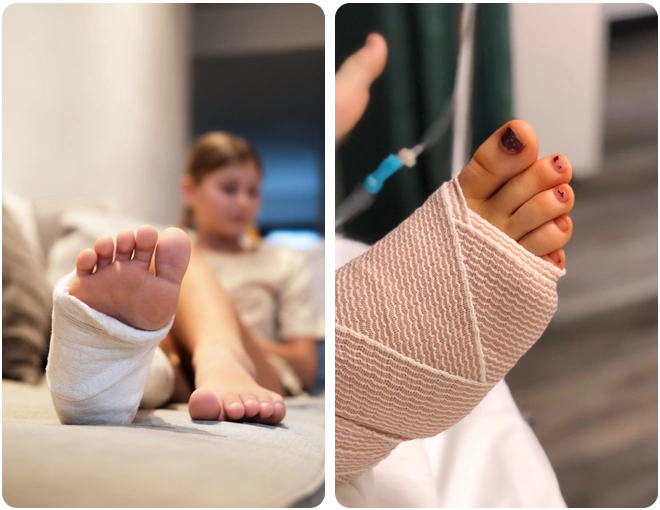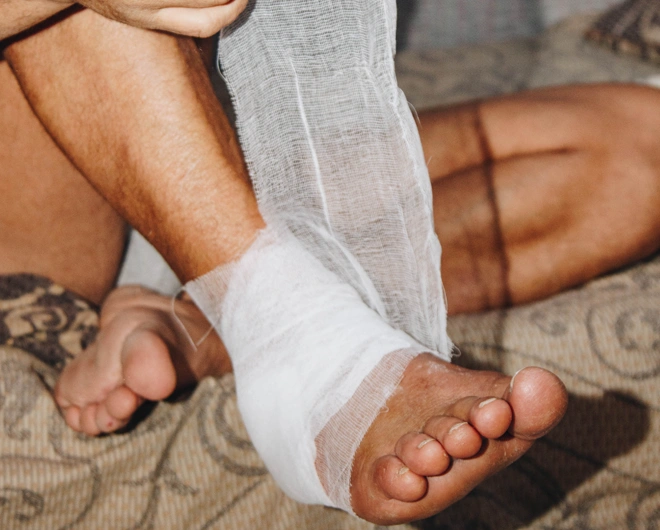Care for an Ulcus cruris
Request a quote for Ulcus Cruris care here!

What an Ulcus cruris looks like
The also known as lower leg ulcers and colloquially as open leg chronic wounds occur in the lower third of the leg, below the knee. From experience, the Alpha Wundexperten know that the wounds are often caused by bumping or scratching.
Depending on the cause, these are superficial or very deep wounds that are difficult to heal. The skin lesions are always due to poor blood circulation in the veins and/or arteries. The disease predominantly affects women. Up to 3% of people over 65 are affected.
Three variants of lower leg ulcers
An Ulcus Cruris is always associated with a circulatory disorder, similar to the diabetic foot. The wounds differ significantly in cases of venous or arterial blood flow disorders. Additionally, there are rare causes such as lymphatic drainage disorders or autoimmune diseases that must be diagnostically clarified by a physician.
Characteristics of a venous Ulcus cruris
70% of cases involve venous lower leg ulcers, which develop due to insufficient venous blood circulation. The wound is usually superficial, with inflamed, uneven edges and occurs mainly in the ankle area. The typically painful wound is a result of chronic venous insufficiency (CVI). This prevents blood from flowing normally in the leg veins, it stagnates in the leg veins and damages the tissue. Often, the skin breaks open without external stimuli.
What wound care is necessary for venous Ulcus cruris?
Venous or predominantly venous lower leg ulcers must be treated by a physician. Treatment generally begins with careful wound cleaning. Routine disinfection is usually omitted to avoid affecting the skin flora. The physician covers the wound with a wound dressing to prevent infection.
The further wound care is provided by the Alpha Wundexperten, who also apply compression bandages to improve venous return and support healing. By wearing compression stockings for life, you can prevent recurrence. Without effective compression therapy, a wound recurs in 97% of cases, with therapy only in about 10%.
Treatment process or Course of treatment
Our comprehensive service for optimal wound healing
A structured treatment process is crucial for the fast and complication-free healing of wounds. We provide personalized care to optimize the healing process.
1

Consultation & Assessment
The first consultation includes a thorough examination of the wound as well as a medical history to optimally plan the healing process.
2

Individual Treatment Plan
Based on the examination, an individual treatment plan is created, taking into account the patient’s specific needs and risks.
3

Treatment & Monitoring
During the treatment, the wound is regularly monitored to ensure healing progress and to make necessary adjustments.
4

Follow-up & Care
After the treatment, regular follow-up is provided to detect potential complications early and to support long-term healing.

Characteristics of an arterial Ulcus cruris
About 10% of cases are due to arterial lower leg ulcers. They develop due to insufficient arterial blood circulation. The wounds begin as a small cut with “punched-out” edges on the leg or foot. They gradually become deeper and can even expose tendons or bones as they increasingly necrotize or turn black. The wounds are very painful.
How is an arterial Ulcus cruris treated?
For wound healing of the Ulcus cruris arteriosum, causal therapy is usually required. To improve blood circulation, vasodilation or bypass surgery is performed. This often creates an additional surgical wound to correct the poor blood circulation. Even the best wound management is not sufficient as long as the blood circulation situation has not improved. For purely arterial lower leg ulcers, compression is not indicated as it can lead to tissue loss.
Complex wound care at home after surgery
Home wound care requires particularly extensive expertise when it comes to treating a surgical wound. Our experts know how to support wound healing after an operation. Naturally, the primary wound care takes place immediately after treatment in the hospital. We ensure the continued wound care at home.
A special case – the mixed Ulcus cruris
Ulcers with mixed etiology, meaning there is both insufficient arterial and venous blood circulation. These wounds show a mixture of the signs and symptoms described above. After initial treatment by a physician, you need intensive care by experienced wound experts. For this condition, a dressing with lower compression pressure may be appropriate.
Ulcus cruris – causes and prevention
Generally, various factors or poor habits influence the occurrence of lower leg ulcers. These include:
How to prevent recurrence of lower leg ulcers
As part of the personal wound visit, we also advise patients on how to prevent another lower leg ulcer:
Use our contact form or send an email (info@Alpha Wundexperten.de) or call us at Tel: 030 / 600 33 977 if you or a relative suffers from Ulcus Cruris.
FAQ’S